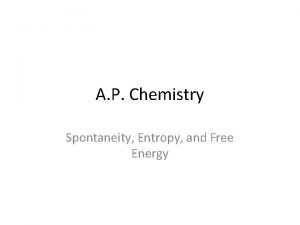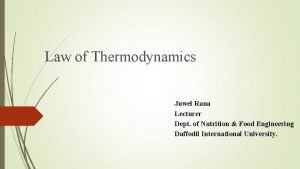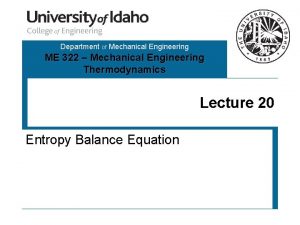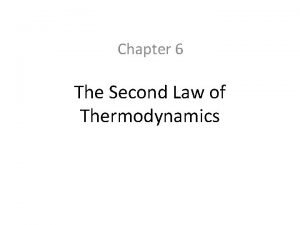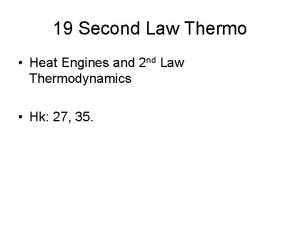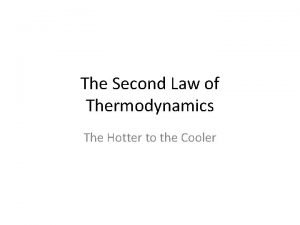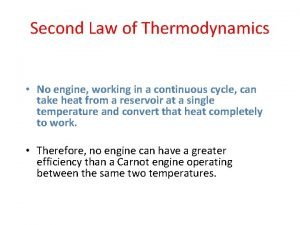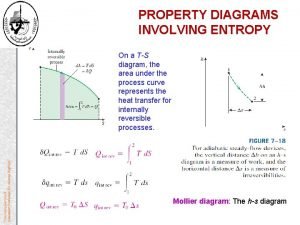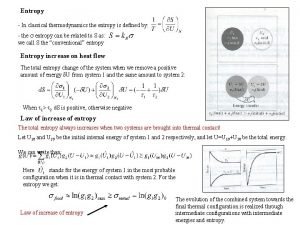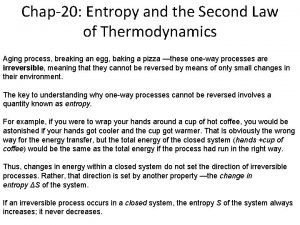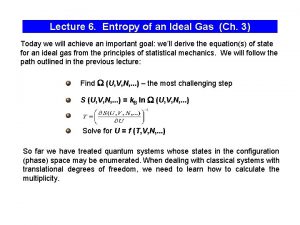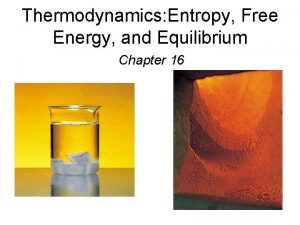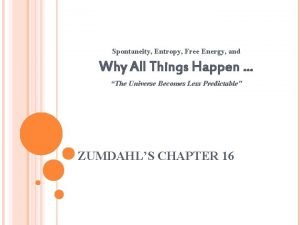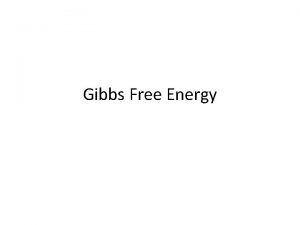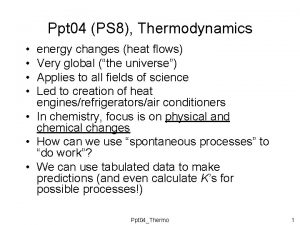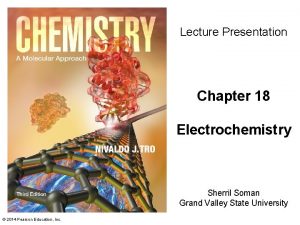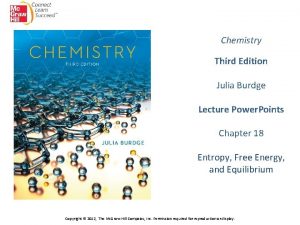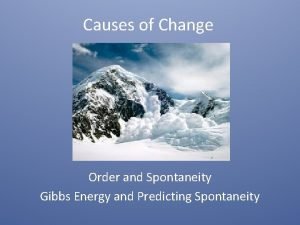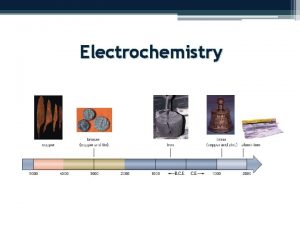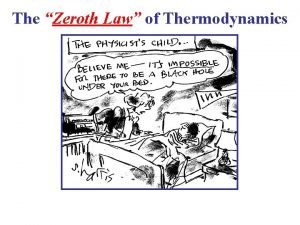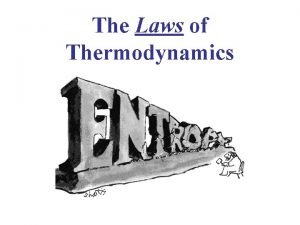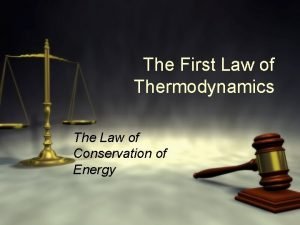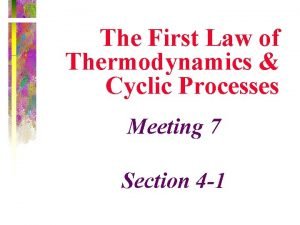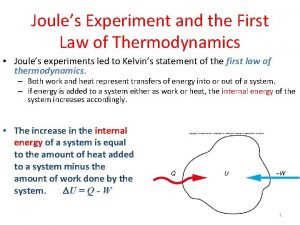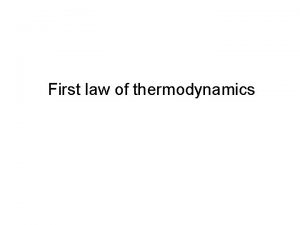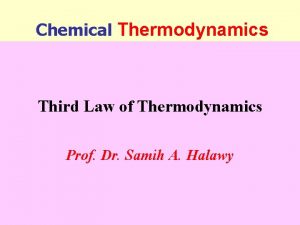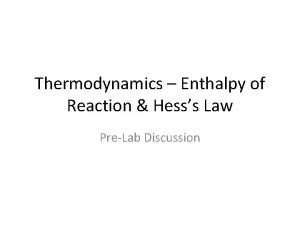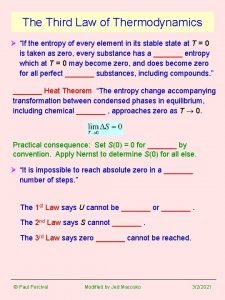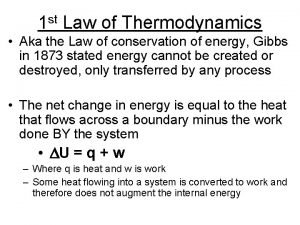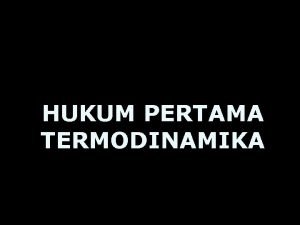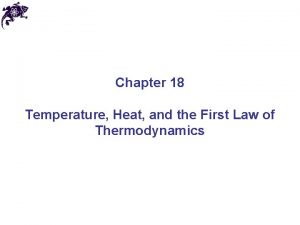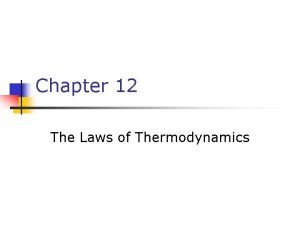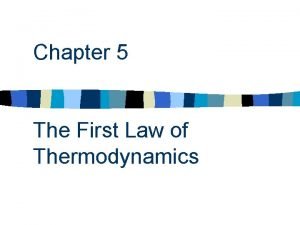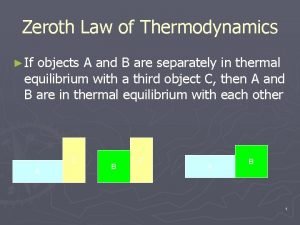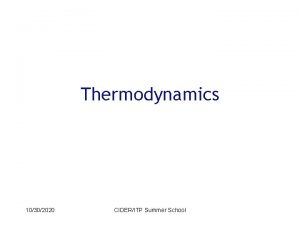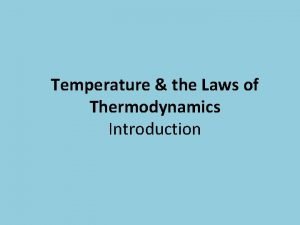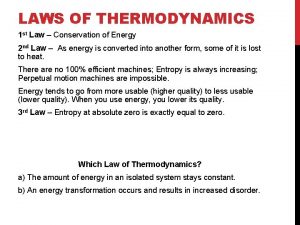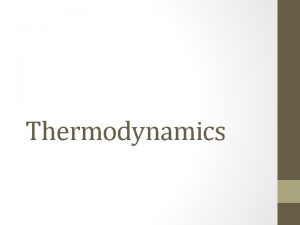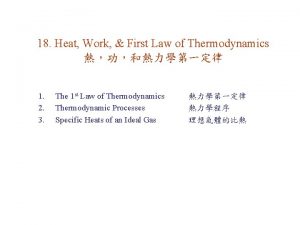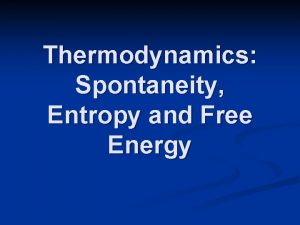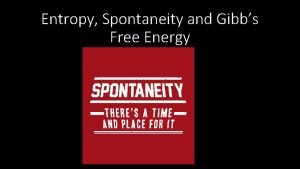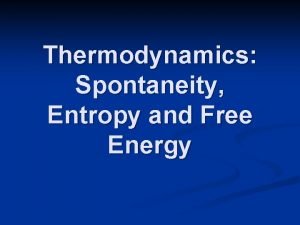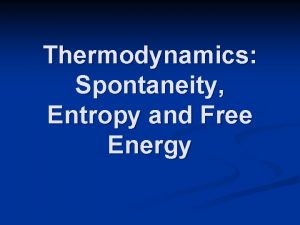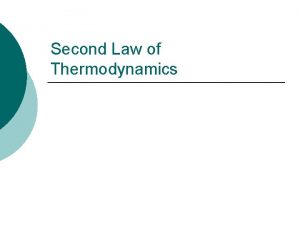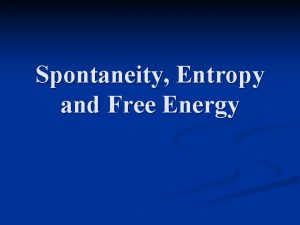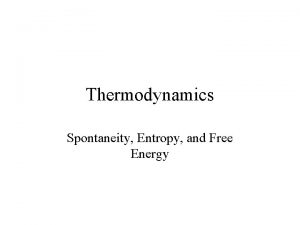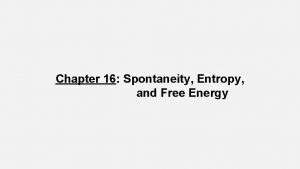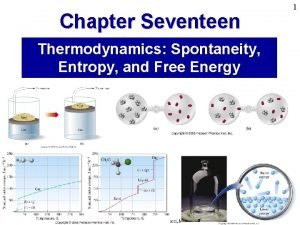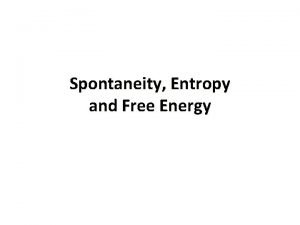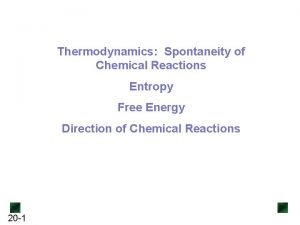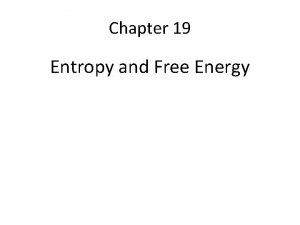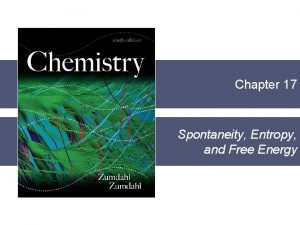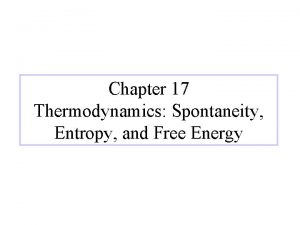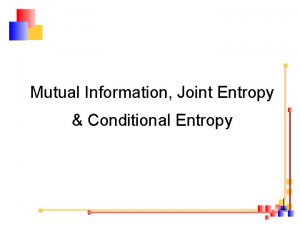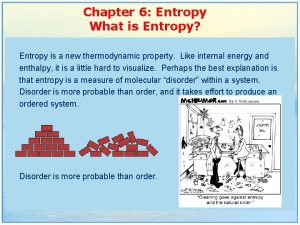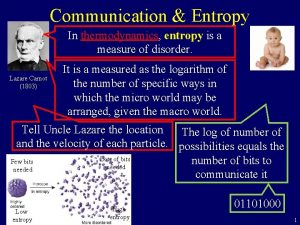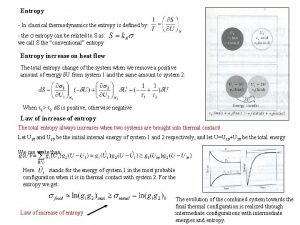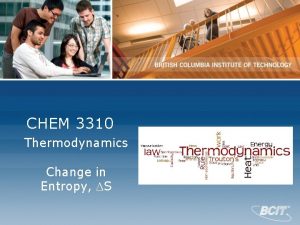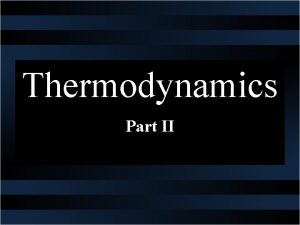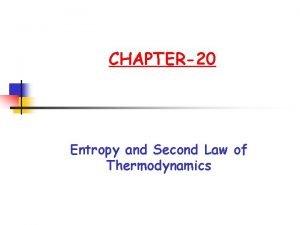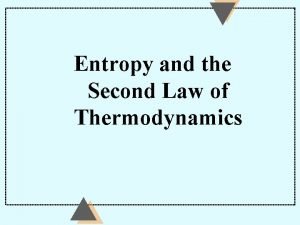THERMODYNAMICS Spontaneity Entropy Criteria for Spontaneity Second Law






























































- Slides: 62

THERMODYNAMICS • • • Spontaneity Entropy: Criteria for Spontaneity Second Law of Thermodynamics Third Law of Thermodynamics Free Energy Coupled Reactions

Thermodynamics • The chemistry that deals with the flow of energy during a chemical or physical process; • Determine whether a reaction is endothermic or exothermic; • Provide criteria to predict whether a reaction is spontaneous or non-spontaneous; • Provide relationship between free energy and work;

Thermodynamics vs. Kinetics • Kinetics Domain Ø Reaction rates depend on the path from reactants to products. • Thermodynamics domain: Ø tells us in which direction energy flows during changes, and whether a reaction is spontaneous or non-spontaneous;

First Law of Thermodynamics • This is the law of conservation of energy Ø Energy cannot be created or destroyed; Ø The energy content of a thermodynamic universe is constant. • For a system that absorbs q amount of heat and does W amount of work, the change in its internal energy ( E) is: E = q + W • For work that only involves gas expansion or compression, W = -p V; (p = pressure exerted on the system)

Enthalpy versus Energy • E = energy change for a process at constant volume; Ø E = q + W = qv; (at constant volume, W = 0) • H = enthalpy or energy change for a process at constant pressure P; Ø H = qp = E – W = E + P V; • q > 0: system absorbs heat; q < 0: system loses heat • W < 0: work done by system; W > 0: work done on system;

Predicting Spontaneous Processes • Thermodynamics allows us to predict whether a process will take occur spontaneously, but it does not tell us how fast it will occur; • A spontaneous process is one that, once it starts, will continue to occur without outside intervention; Ø like a ball rolling down a slope; • A nonspontaneous process one that requires a continuous external intervention to occur; Ø like pushing a bicycle uphill;

A spontaneous but very slow process The conversion of carbon from the diamond to graphite is predicted to be spontaneous at ambient pressure, but its rate is immeasurably slow at low to moderate temperatures. The rate becomes measurable only at temperatures in the 1000– 2000 K range. (credit “diamond” photo: modification of work by “Fancy Diamonds”/Flickr; credit “graphite” photo: modificaton of work by images-of-elements. com/carbon. php)

Expansion of Gas into a Vacuum (Spontaneous and relatively fast) An isolated system consists of an ideal gas in one flask that is connected by a closed valve to a second flask containing a vacuum. Once the valve is opened, the gas spontaneously becomes evenly distributed between the flasks.

The Flow of Heat When two objects at different temperatures come in contact, heat spontaneously flows from the hotter to the colder object.

Scientists responsible for introducing criteria for spontaneity (a) Nicholas Léonard Sadi Carnot’s extensive research on the efficiency of steampowered machinery led to the concept of heat flow and spontaneous process; (b) Rudolf Clausius’s study on Carnot’s work resulted in the introduction of “Entropy” as thermodynamic function for predicting spontaneous processes.

Spontaneous Processes • Some examples of spontaneous processes/reactions: 1. The corrosion of iron is spontaneous, but the reverse is not: 4 Fe(s) + 3 O 2(g) 2 Fe 2 O 3(s) 2. Ice melts spontaneously at room temperature, but water will not freeze at room temperature: H 2 O(s) H 2 O(l) 3. Heat spontaneously flows from a hot object to a cold object if the objects are in contact.

Entropy • A thermodynamic function related to the distribution of heat: Ø A process that is accompanied by an increase in the heat distribution or dispersion implies an increase in entropy, and is a spontaneous process; • Ludwig Boltzmann described entropy as the number of microstates of energy in which a system can exist; Ø A system that can exist in many different microstates of energy has a very high entropy. Ø Entropy is related to the degree of energy states a thermodynamic universe can exist.

What is the significance of entropy? • Nature spontaneously progress into a “situation” that has the highest probability of energy states or highest entropy; • Entropy change is used to predict whether a given process/reaction is thermodynamically possible;

Microstates for 4 Particles in 2 Boxes The sixteen microstates associated with placing four particles in two boxes are shown. The microstates are grouped into five distributions: (a), (b), (c), (d), and (e), based on the numbers of particles in each box.

Microstates for Heat Flow This is a microstate model describing the flow of heat from a hot object to a cold object. (a) Before the heat flow occurs, the object comprised of particles A and B contains both units of energy and as represented by a distribution of three microstates. (b) If the heat flow results in an even dispersal of energy (one energy unit transferred), a distribution of four microstates results. (c) If both energy units are transferred, the resulting distribution has three microstates.

Physical States and Entropy • Entropy can be related to the degree of freedom a system can exist in its microstate. • The more degree of freedom the microstate of a system can exist, the higher its entropy. • Sgas >> Sliquid > Ssolid

Changes in Entropy with Phase Changes The entropy of a substance increases (ΔS > 0) as it transforms from a relatively ordered solid, to a less-ordered liquid, and then to a still less -ordered gas. The entropy decreases (ΔS < 0) as the substance transforms from a gas to a liquid and then to a solid.

Entropy as a Function of Temperature Entropy increases as the temperature of a substance is raised, which corresponds to the greater spread of kinetic energies. When a substance melts or vaporizes, its entropy increases significantly.

Relative Entropy of Substances • Entropy: 1. increases from solid-to-liquid-to-vapor/gas; 2. increases when temperature is increased; 3. increases as gas volume is increased at constant temperature; 4. increases when gases are mixed. 5. increases from top to bottom down a group in the periodic table; 6. increases as the structure of a compound becomes more complex.

Concept Check-#1 Consider 1. 0 moles of a gas contained in a 1. 0 -L bulb at a constant temperature of 25°C. This bulb is connected by a valve to an evacuated 5. 0 -L bulb. At constant temperature, a) What should happen to the gas when the valve is opened? b) What are the values of H, E, q, and w for this process? c) Base on the answers given to parts (a) and (b), what is the driving force for the process?

Concept Check-#2 Predict the sign of S for each of the following, and explain: a) The evaporation of alcohol; b) Snowing; c) Compressing an ideal gas at constant temperature; d) Mixing of gases; e) Dissolving Na. Cl in water.

Standard Entropy Values, So • This is the entropy of a substance in its most stable state at 1 atm and 25 o. C. • For ionic species in solution, it is the entropy of ions in 1 M solution at 25 o. C relative to that of H+(aq), which is assigned zero entropy value.

Standard Entropy Change ( S°) • The standard entropy change ( So) for a reaction is calculated using the following equation: S°reaction = Snp. S°products – Snr. S°reactants

Entropy Change in Chemical Reactions • At constant temperature and pressure, Sorxn = Snp. Soproducts – Snr. Soreactants • In general, Sorxn > 0 if Snp > Snr • Example-1: • C 3 H 8(g) + 5 O 2(g) 3 CO 2(g) + 4 H 2 O(g), (Snp > Snr) Sorxn = {(3 x So. CO 2) + (4 x So. H 2 O)} – {(So. C 3 H 8) + (5 x So. O 2)} • = {(3 x 214) + (4 x 189)}J/K – {270 + (5 x 205)}J/K • = (642 + 756) J/K – (270 + 1025) J/K = 103 J/K

Entropy Change in Chemical Reactions • Example-2: • CO(g) + 2 H 2(g) CH 3 OH(g), (Snp < Snr) Sorxn = (So. CH 3 OH) – {(So. CO) + (2 x (So. H 2)} • • = 240 J/K – {198 J/K + 2 x (131 J/K)} = 240 J/K – 460 J/K = -220 J/K Sorxn < 0 (has a negative value) if Snp < Snr

Second Law of Thermodynamics • A spontaneous process is always accompanied by an increase in the entropy of the universe. • The entropy of universe always increases. Suniverse = Ssystem + Ssurroundings

Second Law of Thermodynamics • Energy flows from a concentrated energy state to a diffused energy state; • Diffusion of energy state is a spontaneous process. • Diffusion of energy state represents increase in entropy; • According to SLo. T, a process is spontaneous if the entropy of the universe increases.

Third Law of Thermodynamics • A perfect crystalline solid at 0 K has no kinetic energy; • A perfect crystalline solid at 0 K with no kinetic energy has only one microstate (W = 1) • According to Boltzmann equation, entropy S = k ln W = k ln (1) = 0 • The entropy of a pure, perfect crystalline solid at 0 K is zero.

ssys versus Ssurr • The algebraic sign of Ssys (+ or -) depends on relative energy distribution before and after the change; • The algebraic sign of Ssurr (+ or -) depends on the direction of the heat flow; Ø Heat flows from system to surrounding, Ssurr > 0; Ø Heat flows from surrounding to system, Ssurr < 0; Ø Magnitude of Ssurr also depends on the temperature at which the exchange of heat occurs.

Magnitude & Algebraic Sign of Ssurr

Magnitude & Algebraic Sign of Ssurr •

Conditions for Spontaneous Process •

Interplay of Ssys and Ssurr in Determining the Sign of Suniv

Gibbs Free Energy, G •

Effect of H and S on Spontaneity

Concept Check-#3 Describe the following as spontaneous/non-spontaneous/cannot tell, and explain. A reaction that is: (a) Exothermic and becomes more random Spontaneous (b) Exothermic and becomes less random Cannot tell (c) Endothermic and becomes more random Cannot tell (d) Endothermic and becomes less random Not spontaneous Explain how temperature would influence your answers.

Free Energy (G) T Suniv = - G (at constnt T and P) • At constant temperature and pressure, a process is spontaneous if G is negative ( G < 0 ; ØA process progress spontaneous in the direction that decreases the free energy, G, until it react equilibrium.

Solar Energy is Free

What Free Energy?

Free Energy, ΔG • It is the maximum amount of chemical energy from a spontaneous reaction that can be utilized to do work or to drive a nonspontaneous process; • Wmax = ΔG • It is the minimum amount of energy that must be supplied to make a nonspontaneous reaction occur.

Free Energy and Work • Maximum work from free energy of a spontaneous process is only achievable in a hypothetical slow reversible process. • In a real process occurring at normal, measurable rate, only a fraction of the free energy can be converted into work; most of it is lost as heat, which is a waste form of energy.

Temperature Dependence of G These plots show the variation in ΔG with temperature for the four possible combinations of arithmetic sign for ΔH and ΔS.

Algebraic Signs of S, H and G There are four possibilities regarding the signs of enthalpy and entropy changes.

Effect of Temperature on G and Spontaneity ————————————————— H S T G Comments Examples ————————————————— - - spontaneous at 2 H 2 O 2(l) 2 H 2 O(l) + O 2(g) • all temperature • + + spontaneous at Ca. CO 3(s) Ca. O(s) + CO 2(g) • high temperature • - low spontaneous at N 2(g) + 3 H 2(g) 2 NH 3(g) • low temperature • + high + nonspontaneous at 2 H 2 O(l) + O 2(g) 2 H 2 O 2(l) • or low all temperature ____________________________ • + high or low high

Standard Free Energy (ΔG°) • Under standard condition, ΔG° = ΔH° – TΔS° • For a reaction under standard condition, ΔG°reaction = Σnp. G°products – Σnr. G°reactants

General Expression for G •

G and Pressure for Phase Equilibrium •

Estimating boiling point from Hvap and Svap •

Estimating Boiling Point •

Estimating Boiling Point •

Concept Check-#4 A liquid is vaporized at its boiling point. Predict the signs of: w – q + H + Ssys + Ssurr – G 0 Explain your answers.

Transition Temperature •

Estimating Transition Temperature •

Estimating Transition Temperature •

Reaction spontaneous at low temperature but not at high temperature ( H < 0; S < 0) Consider the following reaction: • N 2(g) + 3 H 2(g) 2 NH 3(g), Ho = -91. 8 k. J and So = -198. 1 J/K = -0. 1981 k. J/K • At 298 K, T So = 298 K x (-0. 1981 J/K) = -59. 0 k. J Ø Go = Ho - T So = -91. 8 k. J – (-59. 0 k. J) = -32. 8 k. J; Ø Go < 0 reaction is spontaneous at 298 K; • At 500 K, T So = 500 K x (-0. 1981 J/K) = -99. 0 k. J; • Go = Ho - T So = -91. 8 k. J – (-99. 0 k. J) = 7. 2 k. J; Ø Go > 0 reaction is nonspontaneous at 500 K

Reaction spontaneous at high temperature but not at low temperature ( H > 0; S > 0) Consider the following reaction: • CH 4(g) + H 2 O(g) CO(g) + 3 H 2(g), where Ho = 205. 9 k. J and So = 214. 7 J/K = 0. 2147 k. J/K • At 298 K, T So = 298 K x (0. 2147 J/K) = 64. 0 k. J • Go = Ho - T So = 205. 9 k. J – 64. 0 k. J = 141. 9 k. J; Ø Go > 0 reaction is nonspontaneous at 298 K. • At 1000 K, T So = 1000 K x (0. 2147 J/K) = 214. 7 k. J; • Go = Ho - T So = 205. 9 k. J – 214. 7 k. J) = -8. 8 k. J; Ø Go > 0 reaction is spontaneous at 1200 K

G under Nonstandard Conditions •

Free Energy and Equilibrium •

Qualitative Relationship Between Go and K for Reaction

Calculating K from Go •

Coupling Reactions • A nonspontaneous reaction can be coupled to a spontaneous one to make it happen. Example: • Fe 2 O 3(s) 2 Fe(s) + 3/2 O 2(g); Go = 742. 2 k. J (1) • 3 CO(g) + 3/2 O 2(g) 3 CO 2(g); Go = -771. 6 k. J (2) Coupling reactions (1) and (2) yields a net reaction that is spontaneous: • Fe 2 O 3(s) + 3 CO(g) 2 Fe(s) + 3 CO 2(g); Go = -29. 4 k. J

Coupling Reactions in Biological System • The formation of ATP from ADP and H 2 PO 4 - is nonspontaneous, but it can be coupled to the hydrolysis of creatine-phosphate that has a negative Go. ATP + H 2 O; Go = +30 k. J • Creatine-phosphate creatine + phosphate; Go = -43 k. J • ADP + H 2 PO 4 - Coupling the two reactions yields a spontaneous overall reaction: • Creatine-phosphate + ADP Creatine + ATP; Go = -13 k. J
 Ap chem spontaneity entropy and free energy
Ap chem spontaneity entropy and free energy Isentropic process
Isentropic process Zeroth law of thermodynamics
Zeroth law of thermodynamics What is second law of thermodynamics
What is second law of thermodynamics Second law of thermodynamics
Second law of thermodynamics 2nd law of thermodynamics
2nd law of thermodynamics Second law of thermodynamics
Second law of thermodynamics State the second law of thermodynamics
State the second law of thermodynamics Newton's first law and second law and third law
Newton's first law and second law and third law Newton's first law and second law and third law
Newton's first law and second law and third law Entropy thermodynamics
Entropy thermodynamics Total entropy
Total entropy Law of entropy
Law of entropy Entropy of ideal gas
Entropy of ideal gas Law of entropy
Law of entropy Chemistry microstates
Chemistry microstates Gibbs free energy equation units
Gibbs free energy equation units Gibbs free energy vs standard free energy
Gibbs free energy vs standard free energy Thermodynamics ppt
Thermodynamics ppt Predicting spontaneity
Predicting spontaneity Cell reaction
Cell reaction Predicting spontaneity
Predicting spontaneity Complete the following table on reaction spontaneity.
Complete the following table on reaction spontaneity. Predicting redox reactions
Predicting redox reactions 186 282 miles per second into meters per second
186 282 miles per second into meters per second Steady flow energy equation thermodynamics
Steady flow energy equation thermodynamics Zeroth law of thermodynamics
Zeroth law of thermodynamics Third law of thermodynamics derivation
Third law of thermodynamics derivation Thermodynamics laws
Thermodynamics laws First law of thermodynamics
First law of thermodynamics Brayton cycle
Brayton cycle Joule's first law of thermodynamics
Joule's first law of thermodynamics Isothermal process in thermodynamics
Isothermal process in thermodynamics Steady flow process in thermodynamics
Steady flow process in thermodynamics Law of thermodynamics
Law of thermodynamics Thermodynamics enthalpy of reaction and hess's law
Thermodynamics enthalpy of reaction and hess's law Third law of thermodynamics is depend on
Third law of thermodynamics is depend on 1st law of thermodynamics
1st law of thermodynamics First law of thermodynamics sign convention
First law of thermodynamics sign convention 1st law of thermodynamics
1st law of thermodynamics 1st law of thermodynamics
1st law of thermodynamics Enthalpy vs internal energy
Enthalpy vs internal energy Zeroth law of thermodynamics
Zeroth law of thermodynamics Free energy
Free energy Zeroth law of thermodynamics
Zeroth law of thermodynamics Thermodynamics
Thermodynamics Frist law of thermodynamics
Frist law of thermodynamics Thermodynamics of ideal gases
Thermodynamics of ideal gases Boyle's law charles law avogadro's law
Boyle's law charles law avogadro's law Charles law constant
Charles law constant Fspos vägledning för kontinuitetshantering
Fspos vägledning för kontinuitetshantering Typiska drag för en novell
Typiska drag för en novell Tack för att ni lyssnade bild
Tack för att ni lyssnade bild Ekologiskt fotavtryck
Ekologiskt fotavtryck Varför kallas perioden 1918-1939 för mellankrigstiden?
Varför kallas perioden 1918-1939 för mellankrigstiden? En lathund för arbete med kontinuitetshantering
En lathund för arbete med kontinuitetshantering Underlag för särskild löneskatt på pensionskostnader
Underlag för särskild löneskatt på pensionskostnader Tidbok yrkesförare
Tidbok yrkesförare Sura för anatom
Sura för anatom Densitet vatten
Densitet vatten Datorkunskap för nybörjare
Datorkunskap för nybörjare Boverket ka
Boverket ka Att skriva debattartikel
Att skriva debattartikel
